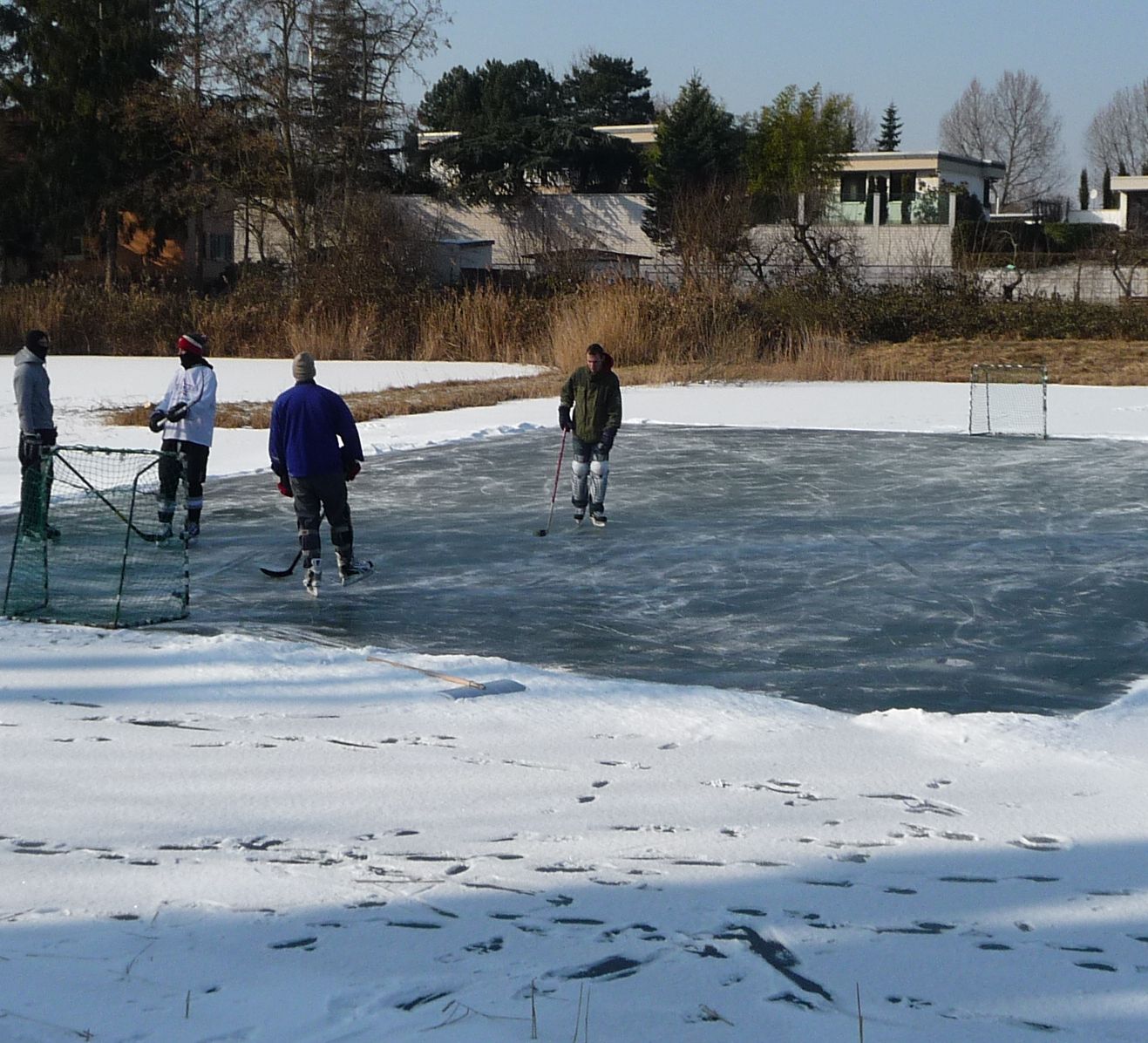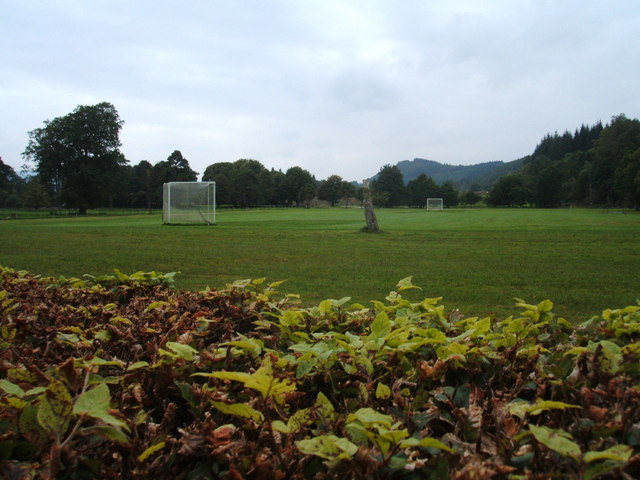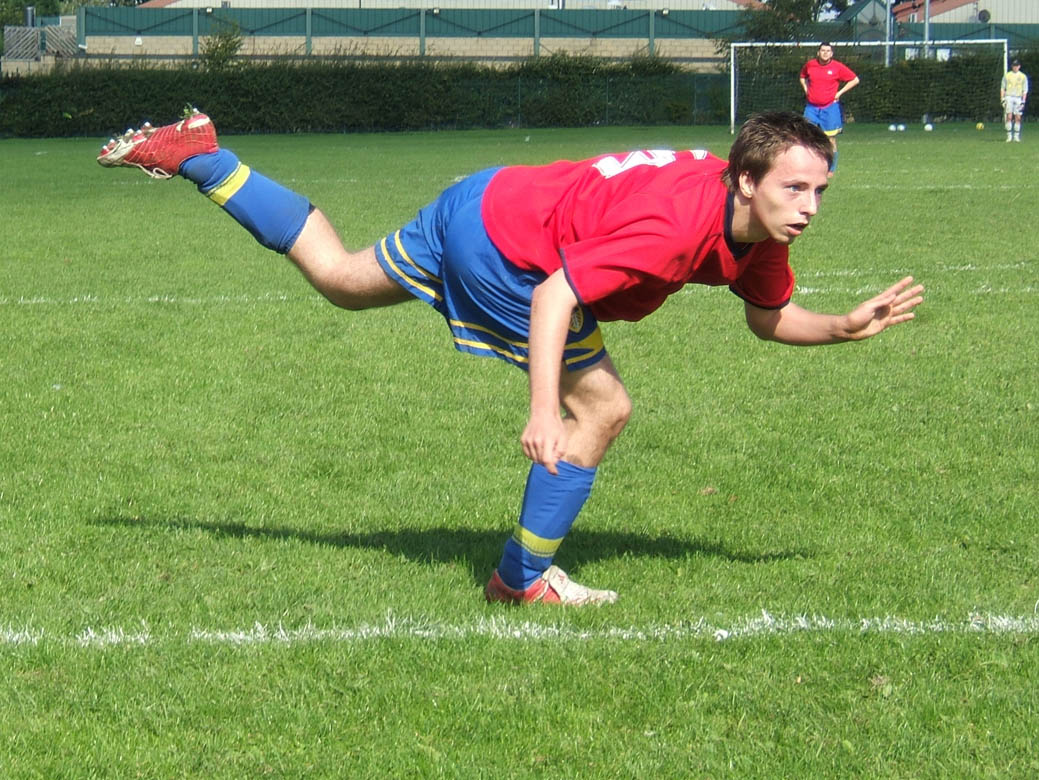|
Shinny
Shinny (also shinney, pick-up hockey, pond hockey, or "outdoor puck") is an informal type of hockey played on ice. It is also used as another term for street hockey. There are no formal rules or specific positions, and often, there are no goaltenders. The goal areas at each end may be marked by nets, or simply by objects, such as stones or blocks of snow. Body checking and lifting or "roofing/reefing/raising the puck" (shooting the puck or ball so it rises above the ice) are often forbidden because the players are not wearing protective equipment. Shinny is a game that all levels of hockey enthusiasts can play because it requires no rink, requires no skills except ability to hold a stick and at the very least to try to touch the puck or ball when it goes by. Shinny may be completely non-competitive and recreational. In his book ''Country on Ice'', Doug Beardsley claims that most Canadian hockey professional players have played some form of shinny in their youth. Team formatio ... [...More Info...] [...Related Items...] OR: [Wikipedia] [Google] [Baidu] [Amazon] |
Pond Hockey
Pond hockey is a form of ice hockey similar in its object and appearance to traditional ice hockey, but simplified and designed to be played on part of a natural frozen body of water. The hockey rink, rink is 50 to 80 percent the size of a standard NHL-specification rink, and has no boards or glass surrounding it; usually only a barrier of snow keeps the puck in play. In addition, because there are no protective barriers behind the goal to contain high errant shots, the top of the goal is lower, in fact only slightly taller than the width of a puck, and the game does not have a formal goaltender, goalie. Because of these differences, pond hockey places more emphasis on skating and puckhandling ability and less on shooting and checking. Non-competitive pond hockey is played with improvised goals, rinks of a variety of sizes, and no boards or snow barriers. There can only be 4 players playing per team at a time but have multiple subs to sub in. There exists a World Pond Hockey Cha ... [...More Info...] [...Related Items...] OR: [Wikipedia] [Google] [Baidu] [Amazon] |
Shinty
Shinty () is a team sport played with sticks and a ball. It is played mainly in the Scottish Highlands and among Highland migrants to the major cities of Scotland. The sport was formerly more widespread in Scotland and even played in Northern England into the second half of the 20th century and other areas in the world where Scottish Highlanders migrated. While comparisons are made with hockey, the two games have several important differences. In shinty a player is allowed to play the ball in the air and use both sides of the stick. The latter is called a , which is wooden and slanted on both sides. The stick may also be used to block and to tackle, although a player may not come down on an opponent's stick, a practice called hacking. Players may also tackle using the body as long as it is shoulder to shoulder. The game was derived from the same root as the Irish game of hurling/ camogie and the Welsh game of bando, but has developed unique rules and features. These rules ... [...More Info...] [...Related Items...] OR: [Wikipedia] [Google] [Baidu] [Amazon] |
Hockey
''Hockey'' is a family of List of stick sports, stick sports where two opposing teams use hockey sticks to propel a ball or disk into a goal. There are many types of hockey, and the individual sports vary in rules, numbers of players, apparel, and playing surface. Hockey includes both summer and winter variations that may be played on an outdoor field, sheet of ice, or an indoor gymnasium. Some forms of hockey require skates, either Inline skates, inline, roller skates, roller or ice skates, ice, while others do not. The various games are usually distnguished by proceding the word ''hockey'' with a qualifier, as in ''field hockey'', ''ice hockey'', ''roller hockey'', ''rink hockey'', or ''floor hockey''. In each of these sports, two teams play against each other by trying to manoeuvre the object of play, either a type of ball or a disk (mathematics), disk (such as a Hockey puck, puck), into the opponent's goal using a hockey stick. Two notable exceptions use a straight stick and ... [...More Info...] [...Related Items...] OR: [Wikipedia] [Google] [Baidu] [Amazon] |
Street Hockey
Street hockey (also known as shinny, dek hockey, ball hockey, road hockey or street roller hockey) is a collection of team sport variants played outdoors either on foot or with wheeled skates (either quad or in-line), using either a ball or puck designed for play on flat, dry surfaces. The object of every game is to score more goals than the opposing team by shooting the ball or puck into the opposing team's net. All games are derivatives of either the sport of ice hockey, floor hockey, bandy, and/or field hockey. Wheeled variants involve the use of inline or roller skates. and variously qualify as either inline hockey or rink hockey (also known as "Quad hockey"). Street hockey in "pickup" form is generally played under the following guidelines since there are no "official rules" for local pickup hockey: * Physical contact between players is extremely limited to avoid injury. * Minimal or no hockey equipment is worn by the runners, depending on players' preferences. * Players ... [...More Info...] [...Related Items...] OR: [Wikipedia] [Google] [Baidu] [Amazon] |
Canadian English
Canadian English (CanE, CE, en-CA) encompasses the Variety (linguistics), varieties of English language, English used in Canada. According to the 2016 Canadian Census, 2016 census, English was the first language of 19.4 million Canadians or 58.1% of the total population; the remainder spoke Canadian French, French (20.8%) or other languages (21.1%). In the province of Quebec, only 7.5% of the population speak English as their mother tongue, while most of Quebec's residents are native speakers of Quebec French. The most widespread variety of Canadian English is Standard Canadian English, spoken in all the western and central provinces of Canada (varying little from Central Canada to British Columbia), plus in many other provinces among urban middle- or upper-class speakers from natively English-speaking families. Standard Canadian English is distinct from Atlantic Canadian English (its most notable subset being Newfoundland English), and from Quebec English. Accent differences ... [...More Info...] [...Related Items...] OR: [Wikipedia] [Google] [Baidu] [Amazon] |
Amateur Ice Hockey
An amateur () is generally considered a person who pursues an avocation independent from their source of income. Amateurs and their pursuits are also described as popular, informal, self-taught, user-generated, DIY, and hobbyist. History Historically, the amateur was considered to be the ideal balance between pure intent, open mind, and the interest or passion for a subject. That ideology spanned many different fields of interest. It may have its roots in the ancient Greek philosophy of amateur athletes competing in the Olympics. The ancient Greek citizens spent most of their time in other pursuits, but competed according to their natural talents and abilities. The "gentleman amateur" was a phenomenon among the gentry of Great Britain from the 17th century until the 20th century. With the start of the Age of Reason, with people thinking more about how the world works around them, (see science in the Age of Enlightenment), things like the cabinets of curiosities, and the writ ... [...More Info...] [...Related Items...] OR: [Wikipedia] [Google] [Baidu] [Amazon] |
Toronto
Toronto ( , locally pronounced or ) is the List of the largest municipalities in Canada by population, most populous city in Canada. It is the capital city of the Provinces and territories of Canada, Canadian province of Ontario. With a population of 2,794,356 in 2021, it is the List of North American cities by population, fourth-most populous city in North America. The city is the anchor of the Golden Horseshoe, an urban agglomeration of 9,765,188 people (as of 2021) surrounding the western end of Lake Ontario, while the Greater Toronto Area proper had a 2021 population of 6,712,341. As of 2024, the census metropolitan area had an estimated population of 7,106,379. Toronto is an international centre of business, finance, arts, sports, and culture, and is recognized as one of the most multiculturalism, multicultural and cosmopolitanism, cosmopolitan cities in the world. Indigenous peoples in Canada, Indigenous peoples have travelled through and inhabited the Toronto area, ... [...More Info...] [...Related Items...] OR: [Wikipedia] [Google] [Baidu] [Amazon] |
Calgary
Calgary () is a major city in the Canadian province of Alberta. As of 2021, the city proper had a population of 1,306,784 and a metropolitan population of 1,481,806 making it the third-largest city and fifth-largest metropolitan area in Canada. Calgary is at the confluence of the Bow River and the Elbow River in the southwest of the province, in the transitional area between the Rocky Mountain Foothills and the Canadian Prairies, about east of the front ranges of the Canadian Rockies, roughly south of the provincial capital of Edmonton and approximately north of the Canada–United States border. The city anchors the south end of the Statistics Canada-defined urban area, the Calgary–Edmonton Corridor. Calgary's economy includes activity in many sectors: energy; financial services; film and television; transportation and logistics; technology; manufacturing; aerospace; health and wellness; retail; and tourism. The Calgary Metropolitan Region is home to Canada' ... [...More Info...] [...Related Items...] OR: [Wikipedia] [Google] [Baidu] [Amazon] |
Edmonton
Edmonton is the capital city of the Provinces and territories of Canada, Canadian province of Alberta. It is situated on the North Saskatchewan River and is the centre of the Edmonton Metropolitan Region, which is surrounded by Central Alberta, Alberta's central region, and is in Treaty 6, Treaty 6 territory. It anchors the northern end of what Statistics Canada defines as the "Calgary–Edmonton Corridor". The area that later became the city of Edmonton was first inhabited by First Nations in Alberta, First Nations peoples and was also a historic site for the Métis in Alberta, Métis. By 1795, many trading posts had been established around the area that later became the Edmonton census metropolitan area. "Fort Edmonton", as it was known, became the main centre for trade in the area after the 1821 merger of the Hudson's Bay Company and the North West Company. It remained sparsely populated until the Canadian acquisition of Rupert's Land in 1870, followed eventually by the arri ... [...More Info...] [...Related Items...] OR: [Wikipedia] [Google] [Baidu] [Amazon] |
Montreal
Montreal is the List of towns in Quebec, largest city in the Provinces and territories of Canada, province of Quebec, the List of the largest municipalities in Canada by population, second-largest in Canada, and the List of North American cities by population, ninth-largest in North America. It was founded in 1642 as ''Fort Ville-Marie, Ville-Marie'', or "City of Mary", and is now named after Mount Royal, the triple-peaked mountain around which the early settlement was built. The city is centred on the Island of Montreal and a few, much smaller, peripheral islands, the largest of which is Île Bizard. The city is east of the national capital, Ottawa, and southwest of the provincial capital, Quebec City. the city had a population of 1,762,949, and a Census geographic units of Canada#Census metropolitan areas, metropolitan population of 4,291,732, making it the List of census metropolitan areas and agglomerations in Canada, second-largest metropolitan area in Canada. French l ... [...More Info...] [...Related Items...] OR: [Wikipedia] [Google] [Baidu] [Amazon] |
Eaton's
The T. Eaton Company Limited, later known as Eaton's, was a Canadian department store chain that was once the largest in the country. It was founded in 1869 in Toronto by Timothy Eaton, an immigrant from what is now Northern Ireland. Eaton's grew to become a retail and social institution in Canada, with stores across the country, buying-offices around the globe, and a mail-order catalog that was found in the homes of most Canadians. A changing economic and retail environment in the late twentieth century, along with mismanagement, culminated in the chain's bankruptcy in 1999. Eaton's pioneered several retail innovations. In an era when haggling for goods was the norm, the chain proclaimed "We propose to sell our goods for CASH ONLY – In selling goods, to have only one price." In addition, it had the long-standing slogan "Goods Satisfactory or Money Refunded." Early years In 1869, Timothy Eaton sold his interest in a small dry-goods store in the market town of St. Marys, ... [...More Info...] [...Related Items...] OR: [Wikipedia] [Google] [Baidu] [Amazon] |








